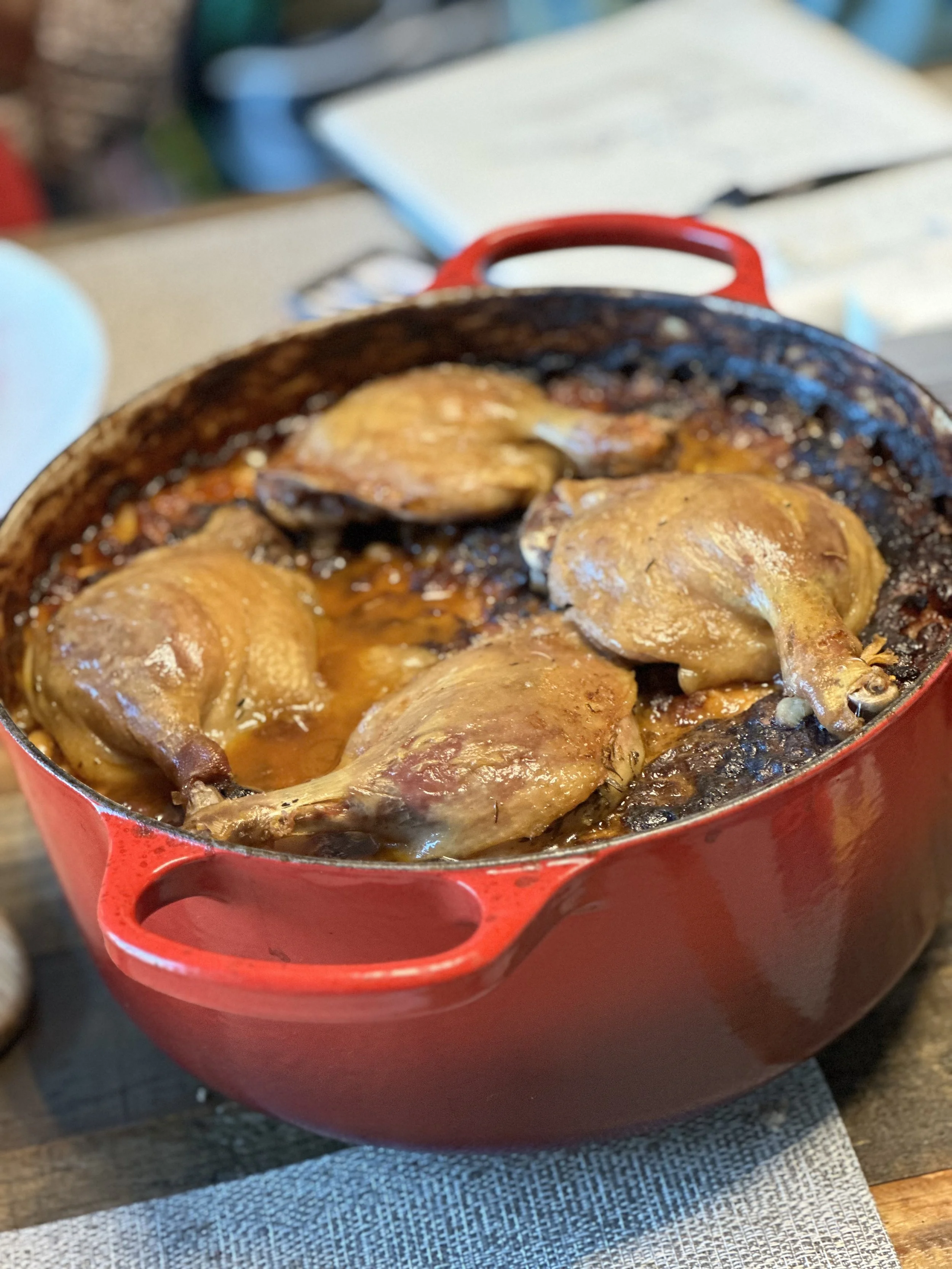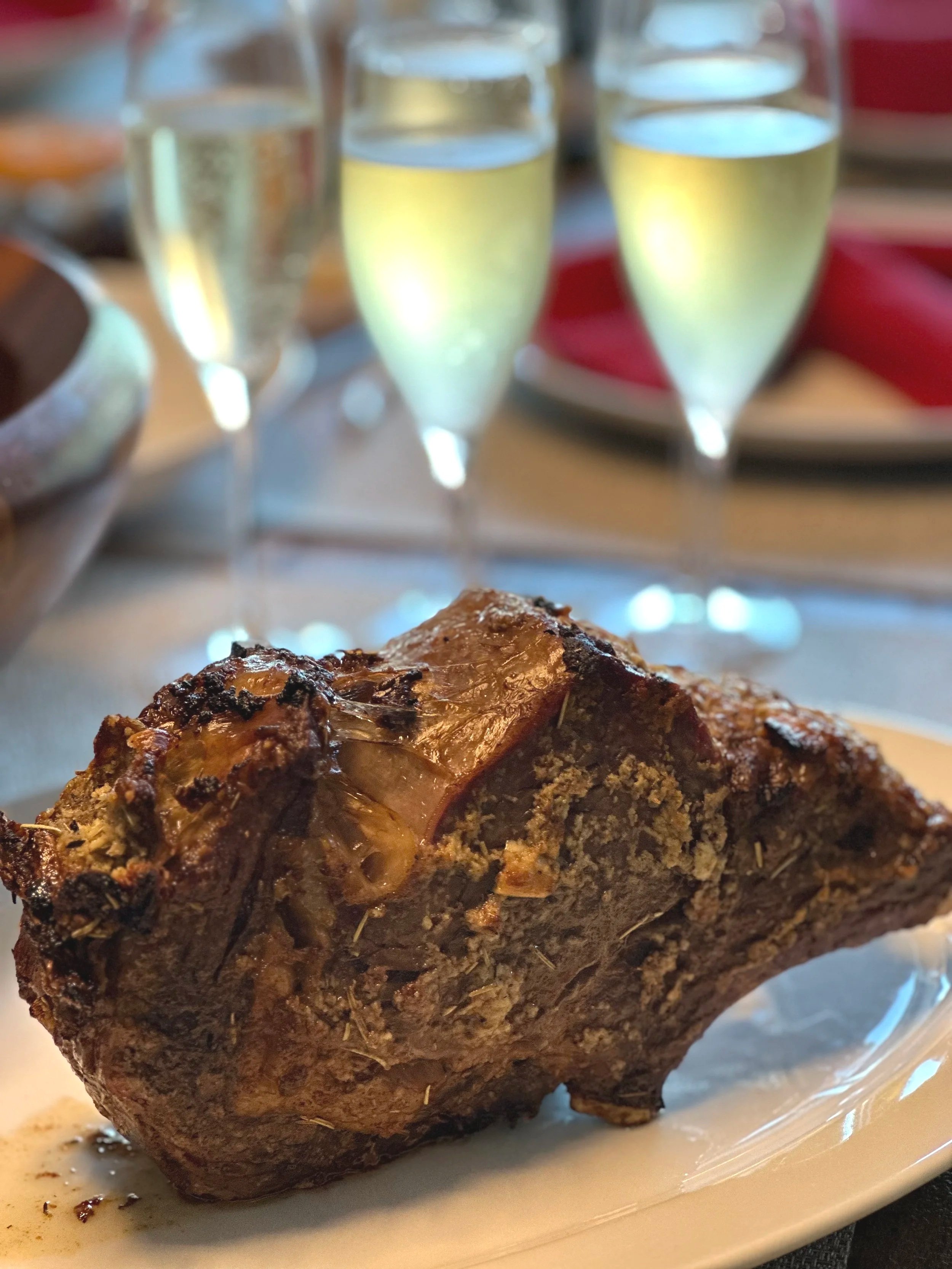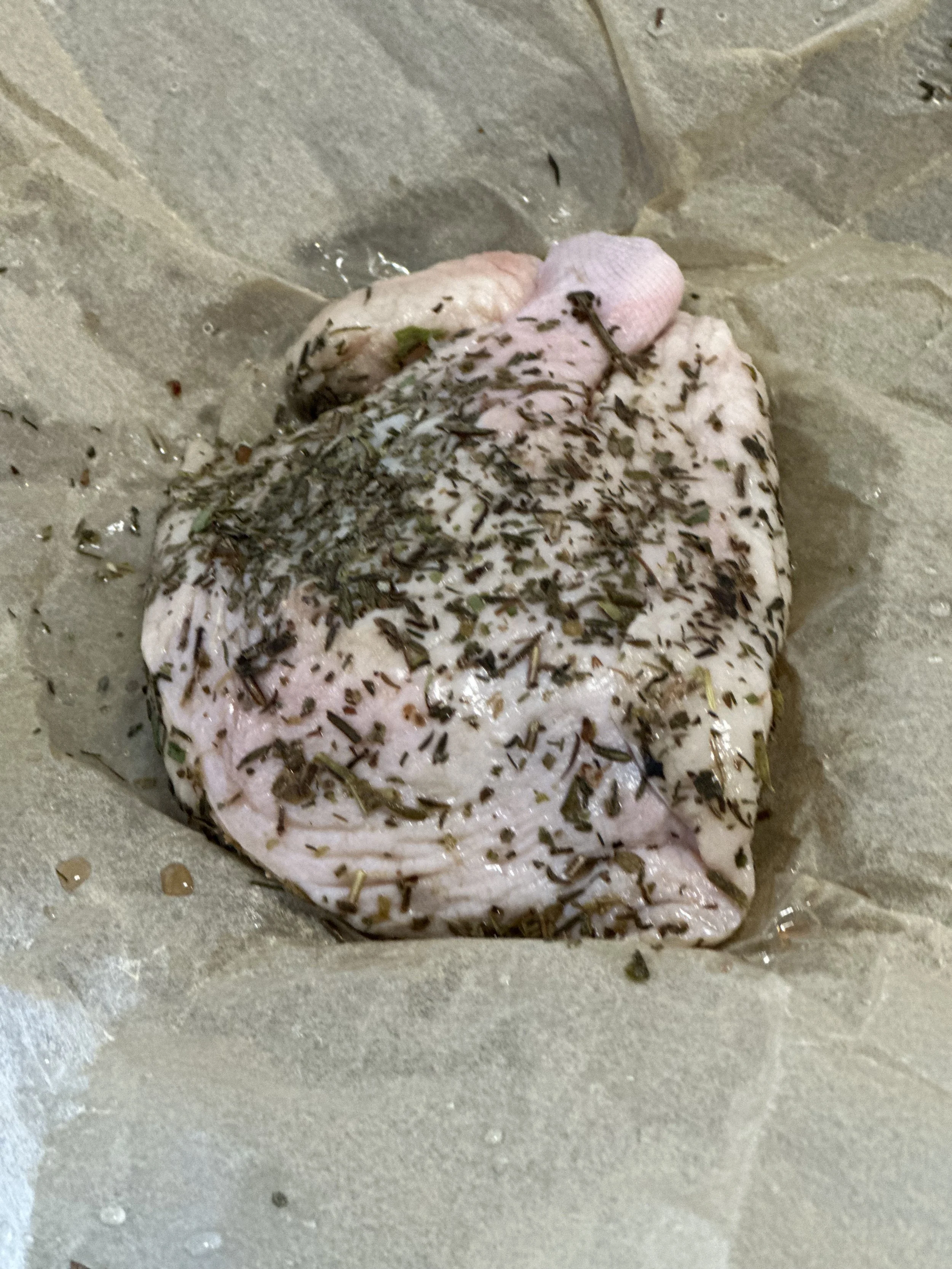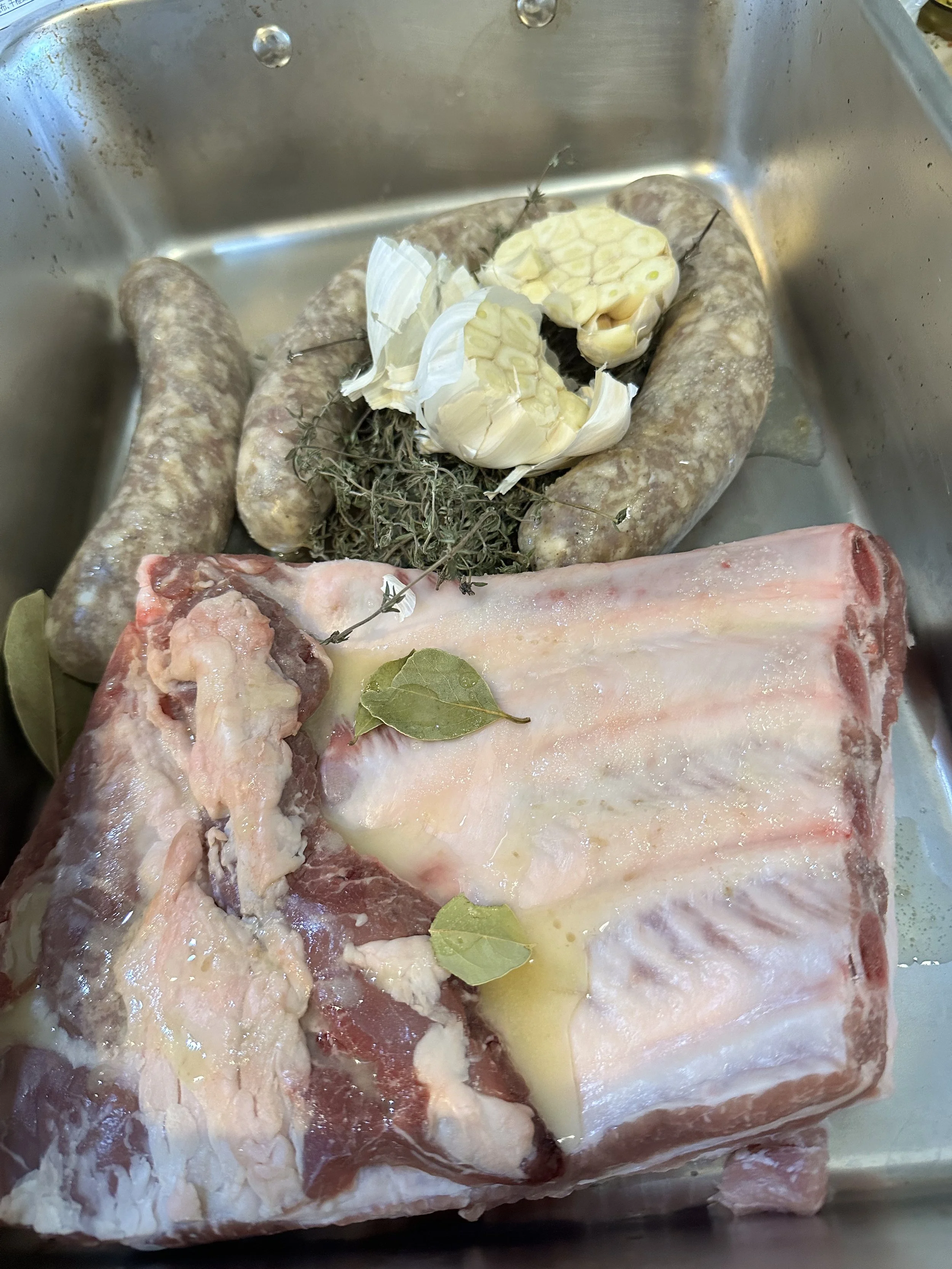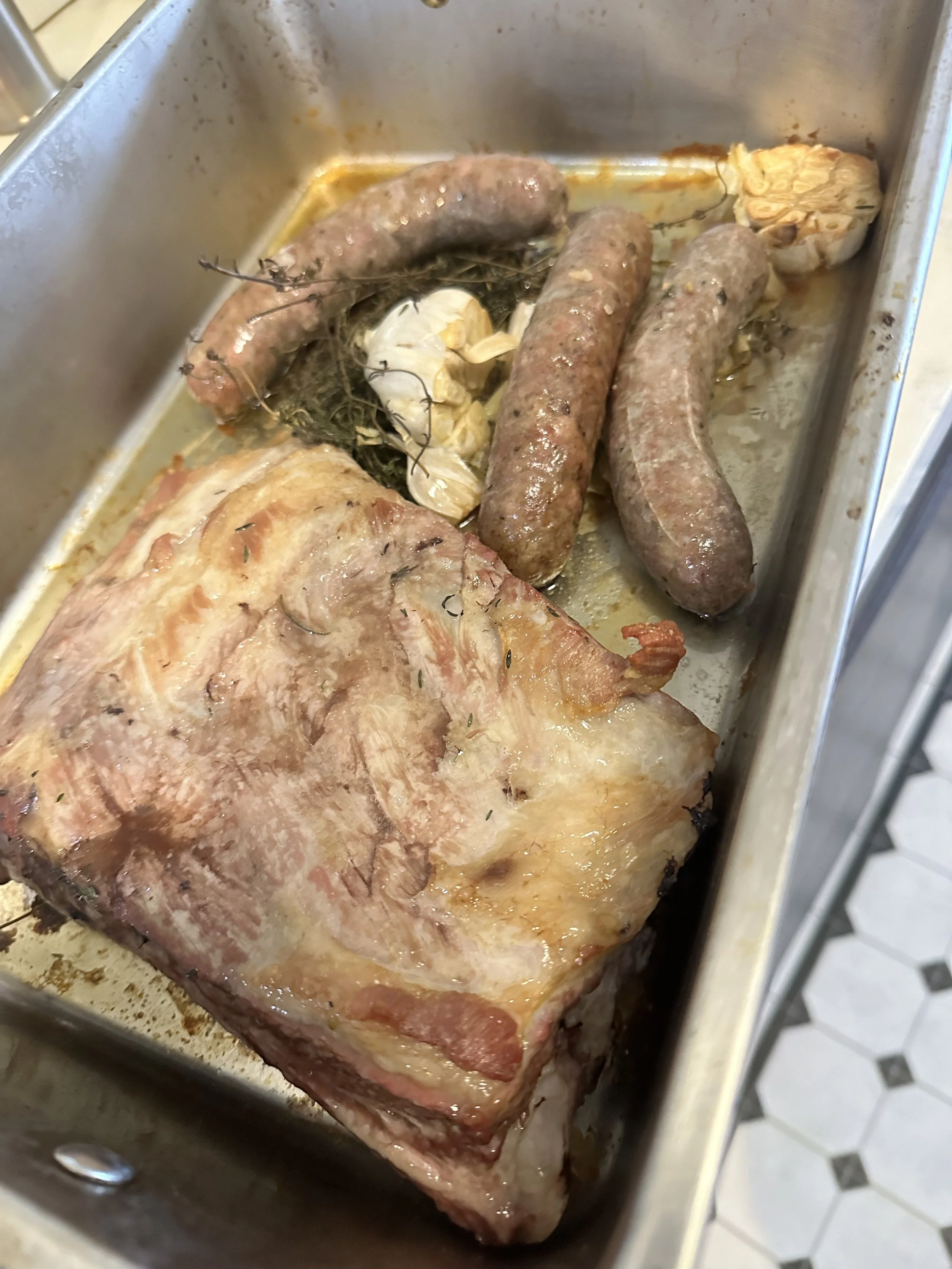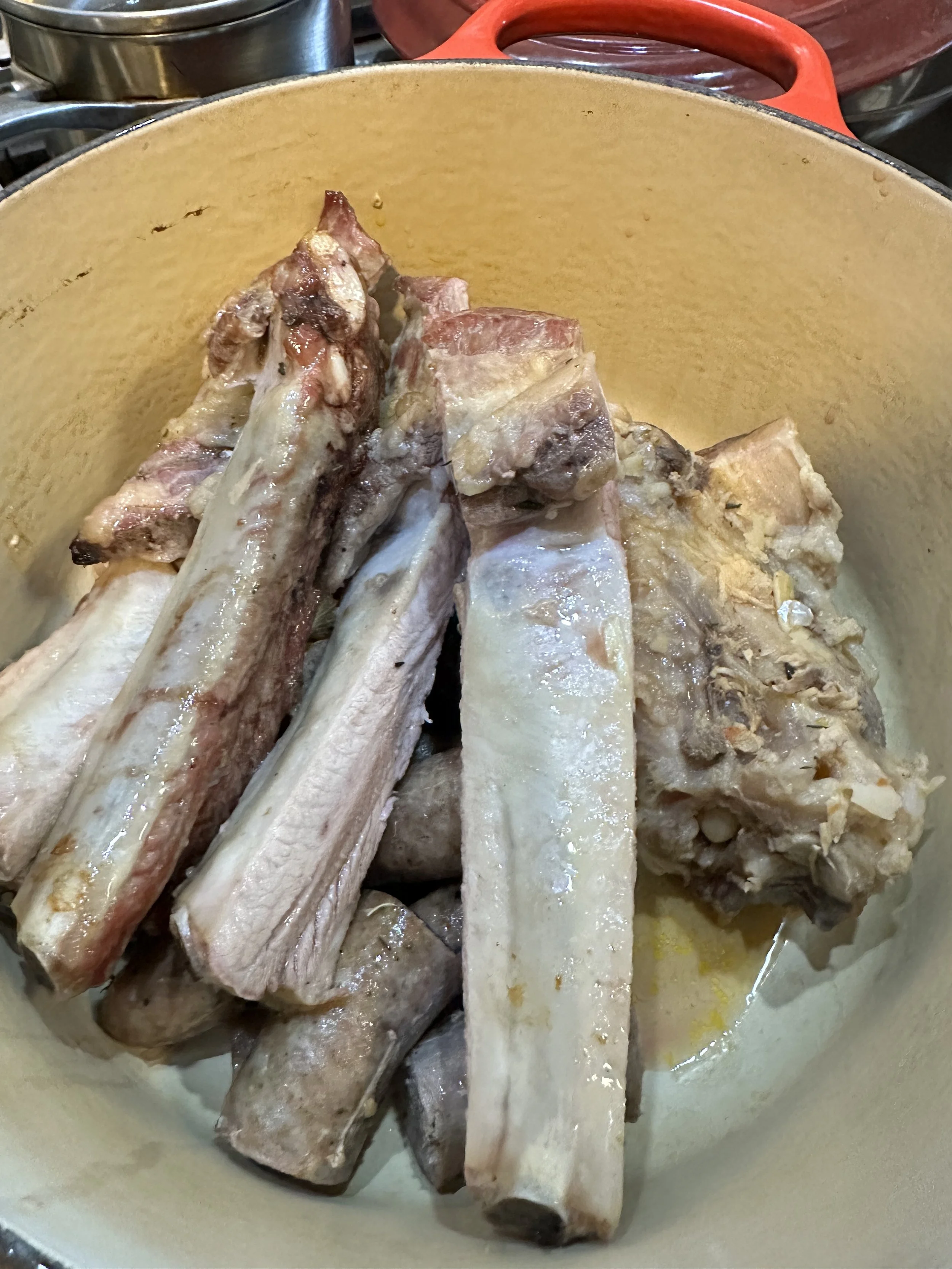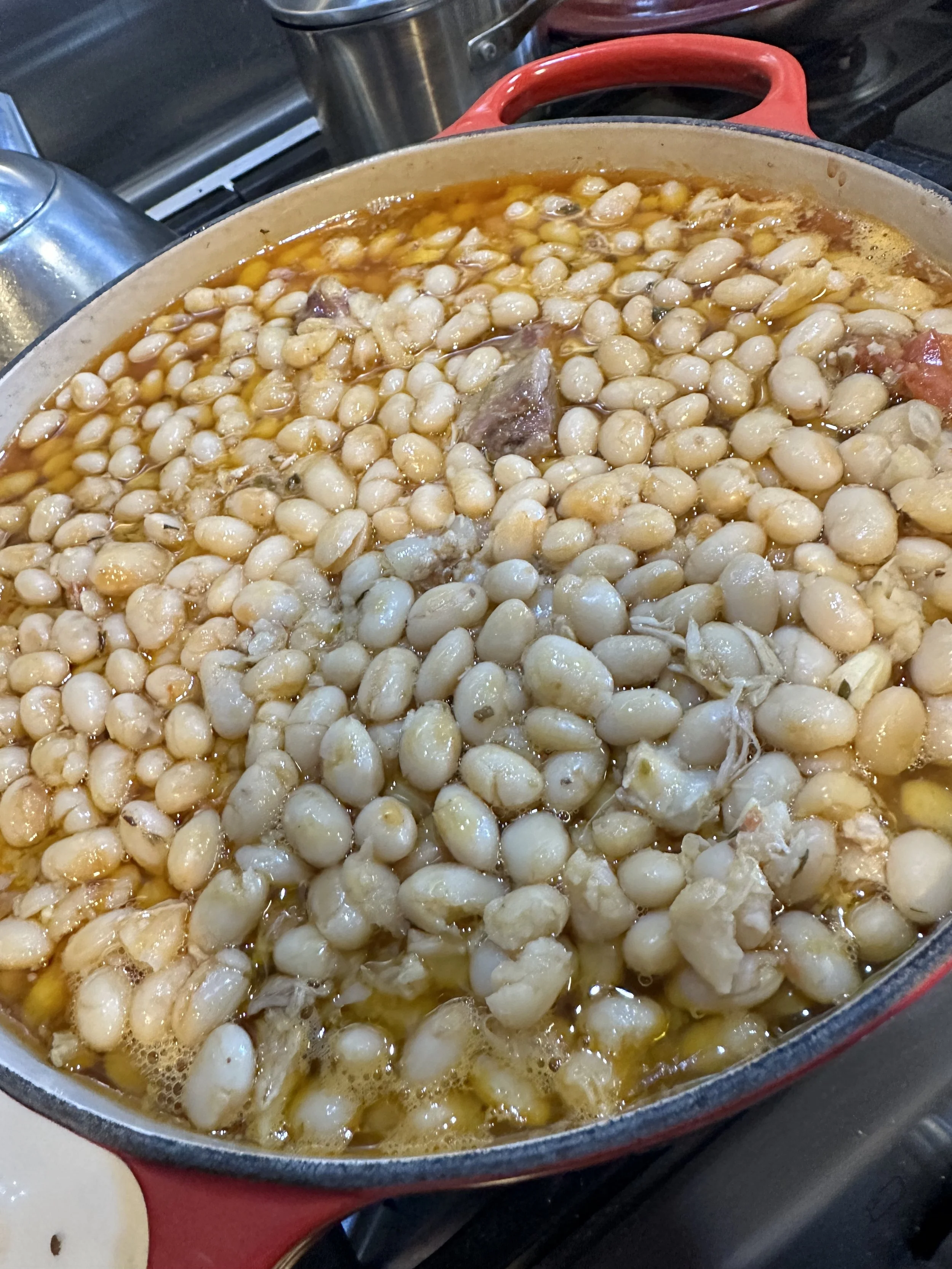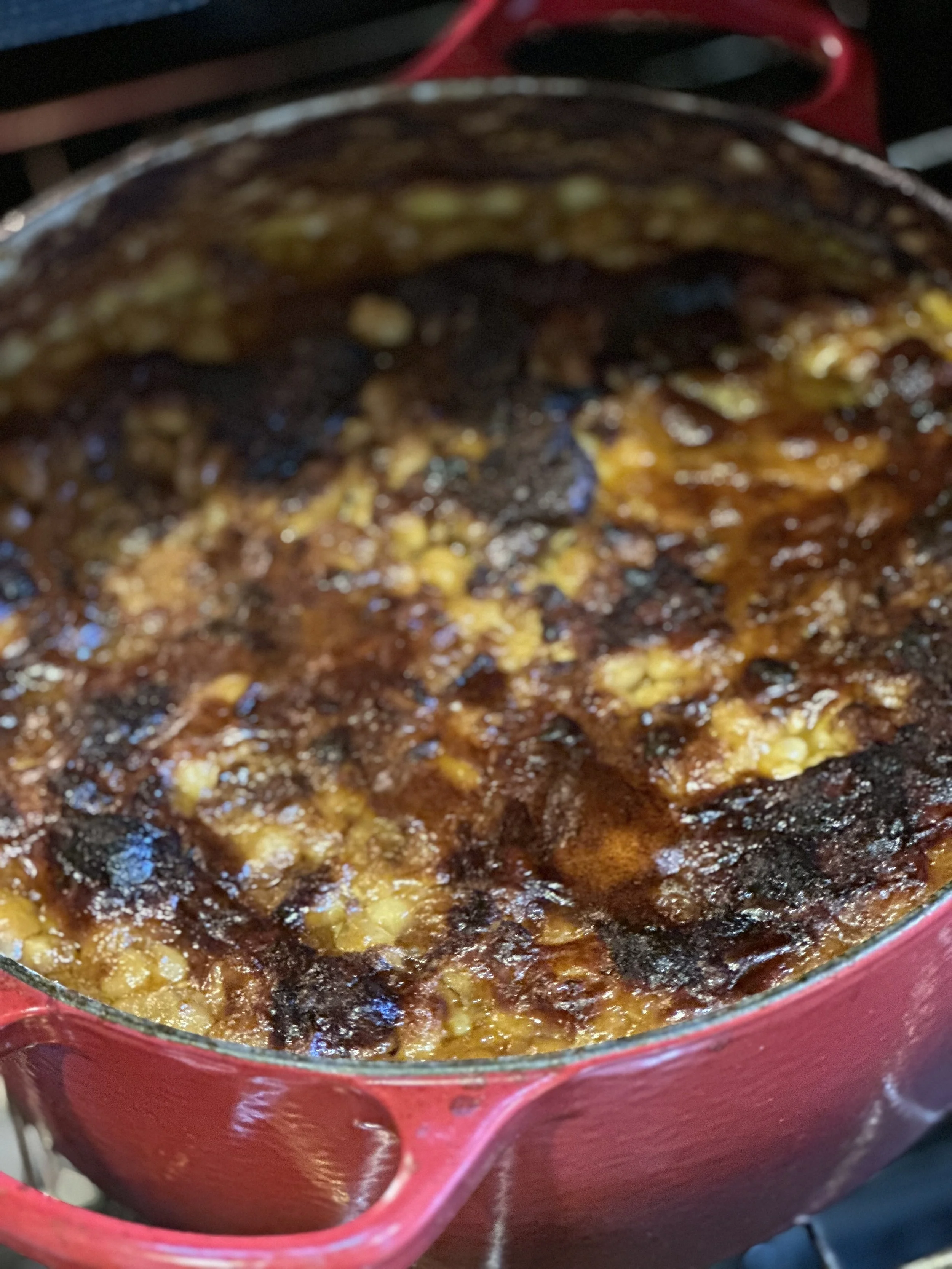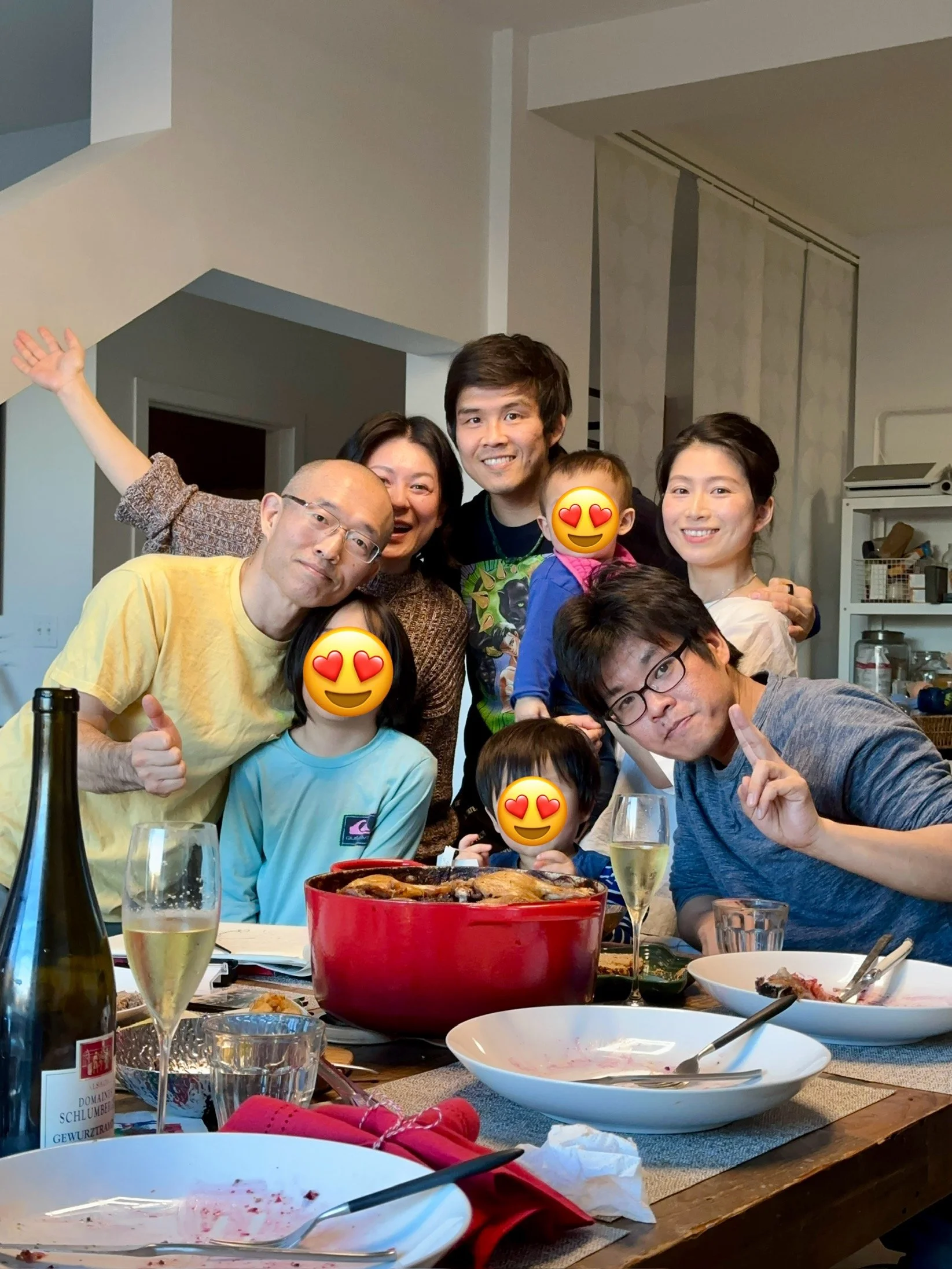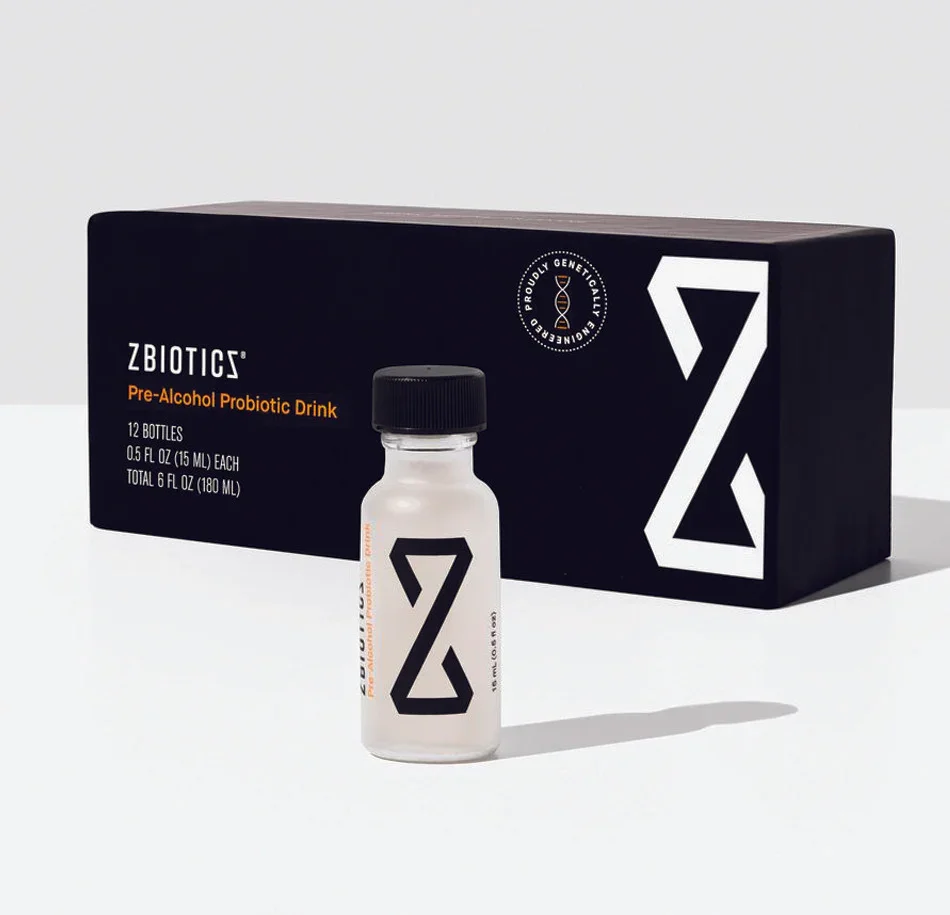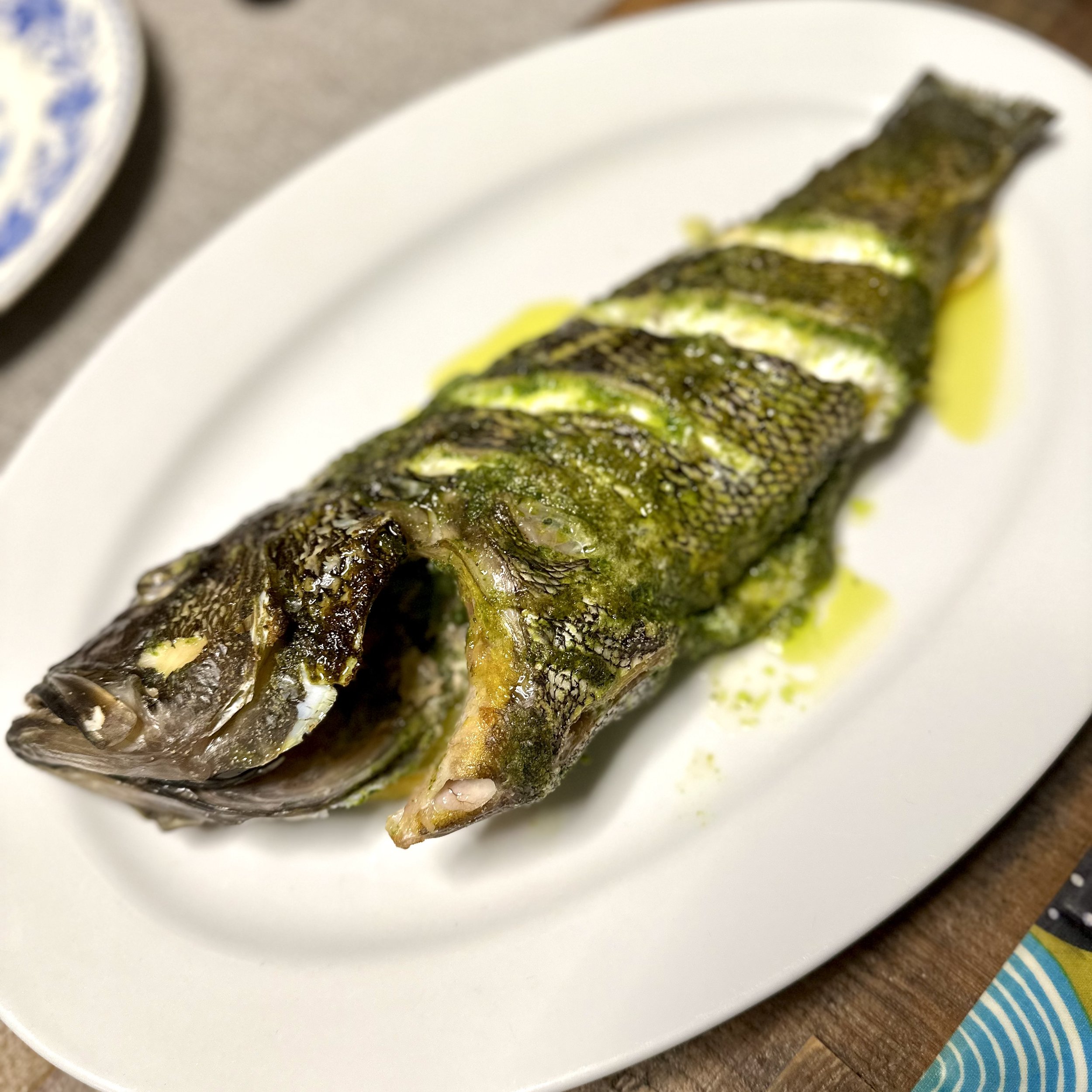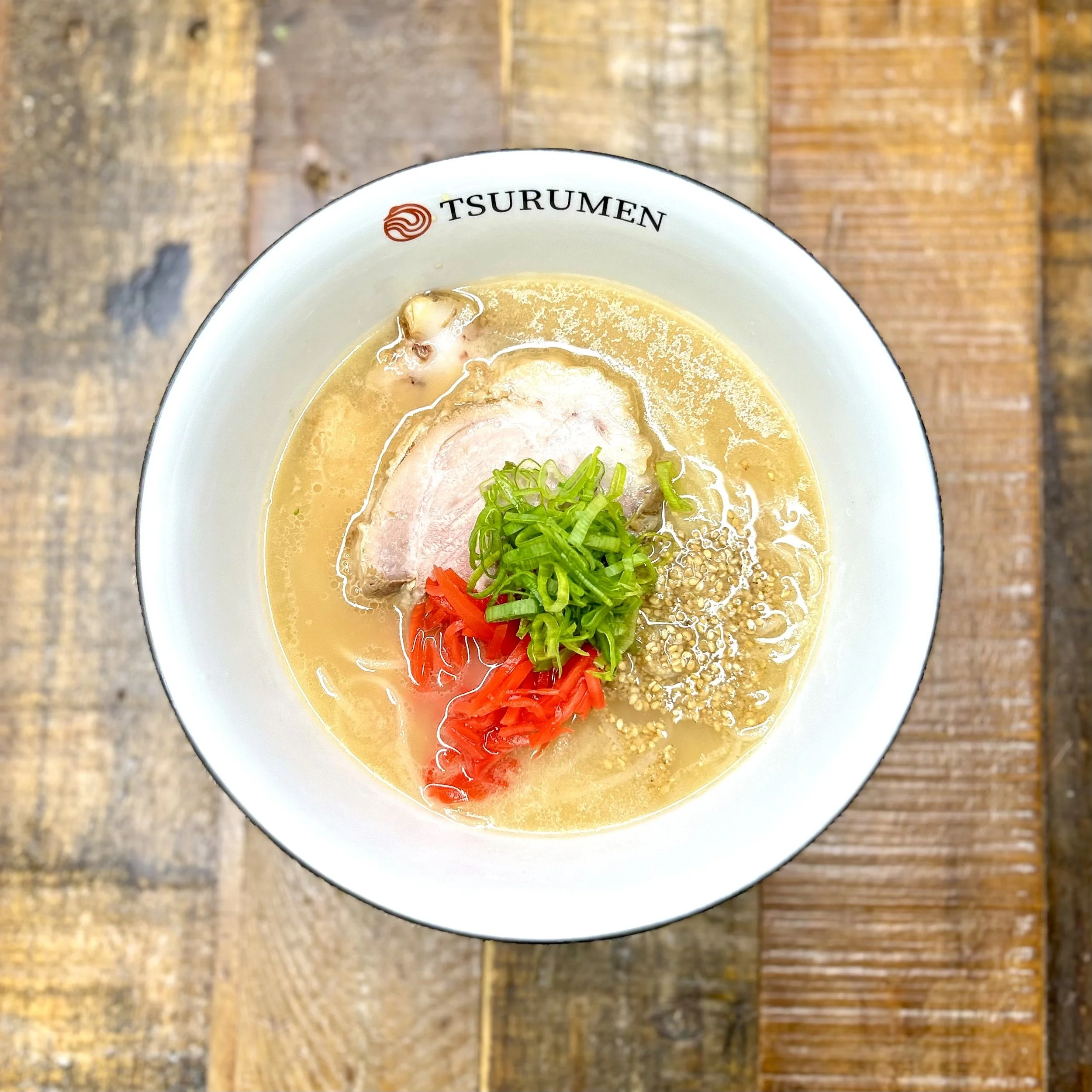French Cassoulet 2023
French Cassoulet
The Christmas Cassoulet: When Your BJJ Brother Brings Steak to a Meat Feast
It's Christmas at the Matsuda house. The tree is lit. Champagne glasses are lined up on the table. And I've been cooking for over a week.
Cassoulet. The ultimate French winter feast. This is our family tradition now. Not turkey. Not ham. Cassoulet.
But here's what happened this year: my younger brother flew in from Japan. The Takashima family drove up from New York. And Takashima-san - my old BJJ training partner, a black belt - walked through the door carrying a bag.
"I brought ribeye steaks," he said, grinning.
I laughed. "There's already a duck, pork ribs, pork hock, and chorizo in this cassoulet."
He shrugged. "More meat is always better."
He's not wrong.
Ribeye steak by Takashima-san
The Old Days: Train and Eat
Back when Takashima lived in Boston, we had a routine. Train BJJ. Eat meat. That was it.
We'd roll for two hours at the gym - drilling takedowns, working submissions, sparring until we were exhausted. Then we'd go somewhere and destroy a massive meal. BBQ. Brazilian churrascaria. Didn't matter. We needed PROTEIN.
That was years ago. Before kids. Before responsibilities. When it was just two guys obsessed with training and recovery.
Now? We both have families. He's in New York. I'm in Boston. We don't roll anymore. But when he comes to visit? We still eat meat.
Some traditions don't change.
Petit Salé
A Week Before: Petit Salé
Real cassoulet doesn't start two days before. It starts a WEEK before.
Seven days before Christmas, I broke down the whole duck. Thighs for confit. I rubbed them heavily with coarse salt, thyme, and garlic. This is petit salé - the old French preservation technique. Salt cure.
I wrapped the thighs and put them in the fridge. Let them cure for a week. The salt draws out moisture, concentrates flavor, and changes the texture of the meat. This isn't just seasoning - this is TRANSFORMATION.
The duck bones? I deboned them carefully and threw them in the freezer. They'd wait there until I needed them for stock.
This is how the French did it. Before refrigeration. Before modern grocery stores. You preserved meat with salt. You saved every bone for stock. Nothing wasted.
The Day Before: The Stock
The day before Christmas, I pulled those frozen duck bones out. Roasted them at high heat until they were deep brown. That's where the color and depth come from. And then, the most important part is rendering duck fat from duck fat. I need fat for confit and cooking later.
Then into a pot with water, aromatics, and vegetables. Simmered for hours. The smell filled the whole house. My daughter kept asking, "When is Christmas dinner?"
"Tomorrow," I told her. "This is just the preparation."
That stock - rich, golden, full of gelatin from the bones - would become the liquid for the beans. This is why you save bones. This is why you plan ahead.
Christmas Morning: The Assembly
Christmas morning, I woke up early. Time to build the cassoulet.
First, the beans. Two pounds of cannellini beans, soaked overnight. I cooked them in the duck stock with tomatoes, carrots, onion, garlic, cloves, tomato paste, thyme, and a splash of apple cider vinegar for acidity.
While the beans simmered, I roasted the pork spare ribs and pork hock. Just salt, pepper, herbs. Into the oven at 400°F until they got some color. Not fully cooked - they'll finish in the cassoulet.
Then the chorizo. I browned it in a pan to render some of that fat and get crispy edges.
The kitchen smelled INSANE. My brother walked in, half asleep. "This is why I flew from Japan."
The pod is already filled with lots of meat
Covered up with beans
Duck confit is 90% ready (the only process is geeting skin crispy)
The Layering
Here's how you build cassoulet:
Start with a layer of beans in your biggest pot - I used my red Le Creuset Dutch oven. Then the pork ribs. Then more beans. Then the chorizo. Then more beans. Then the duck confit on top - those legs I cured a week ago, now impossibly tender and perfect.
Pour in enough of the bean cooking liquid so everything is barely covered. Not swimming - just moist.
Then into a 400°F oven for 30-40 minutes. What you're looking for is CRUST. The top layer of beans and meat should caramelize. Bubble. Turn golden-brown. That crust is everything.
Controlling crispiness and liquid amount
The Feast
By the time everyone arrived, the cassoulet was ready. I pulled it out of the oven - bubbling, dark, caramelized on top. Set it right on the table in the pot.
Takashima saw it and whistled. "That's beautiful."
We had champagne ready. A big salad with bitter greens to cut the richness. Red napkins folded like bows. Christmas tree lit in the background.
I scooped out portions - making sure everyone got duck, pork, chorizo, and those tender white beans that had absorbed all that duck stock and pork fat.
Cast Iron does all jobs
First bite. Rich. Savory. That duck confit - cured for a week, cooked in fat for hours - just MELTED. The pork ribs fell off the bone. The beans were creamy on the inside, crusty on top where they'd caramelized.
My daughter looked at Takashima's kids. "This is SO good."
Takashima raised his champagne glass. "Can we come next year again?"
"Mi case es tu casa" I answered to my senpai.
We train at different places. But we still gather. We still eat. And that matters just as much.
Because more meat is ALWAYS better.
-
2025
- Nov 2, 2025 thanksgiving 2025
- Feb 14, 2025 Baked Pesto Black Sea Bass
- Jan 31, 2025 Veal with Maitake Cream Sauce
- Jan 1, 2025 Osechi 2025
-
2024
- Dec 25, 2024 French Cassoulet 2024
- Nov 28, 2024 Thanksgiving 2024
- Nov 2, 2024 Tonkotsu Ramen
- Oct 6, 2024 Pork Chop with New England Apple Sauce
- Sep 27, 2024 Tsukemen: The Dipping Noodle
- Sep 6, 2024 Chicken Paitan Ramen Yeah K style
- Aug 14, 2024 New England Shio Ramen
- Jul 14, 2024 Miso Tanmen
- Jun 20, 2024 Chashu Pork & Chicken Oil: The Secret to Restaurant-Quality GF Ramen at Home
- Jun 16, 2024 The Boston Paella
- May 4, 2024 Beef Tongue Stew
- Apr 25, 2024 Classic Gluten-free chicken shoyu ramen
- Feb 22, 2024 Vegan Gluten-Free Ramen
- Jan 31, 2024 Grilled Artichoke Salad with a sprinkle of reindeer bone broth
- Jan 1, 2024 Osechi 2024
-
2023
- Dec 25, 2023 French Cassoulet 2023
- Dec 24, 2023 Christmas Eve Duck Breast
- Nov 29, 2023 Thanksgiving 2023
- Sep 24, 2023 Roast Beef Bowl
- Jul 4, 2023 Black Ink Paella
- Jun 17, 2023 Ribeye Steak at a campsite
- May 14, 2023 Biceps Rissoto
- Feb 14, 2023 Chicken Confit
- Jan 31, 2023 Wild Boar with Wagyu Ragù
- Jan 8, 2023 Lobster and Salmon Roe Pasta
- Jan 7, 2023 “Okuizome” (first meal) for Lui
- Jan 1, 2023 Osechi 2023
-
2022
- Dec 25, 2022 French Cassoulet 2022
- Dec 24, 2022 Duck breast marmalade
- Nov 24, 2022 Thanksgiving 2022
- Nov 19, 2022 Buffalo Testicle
- Nov 6, 2022 Meal Prep for my Family
- Aug 21, 2022 Pescatore Boston
- Aug 14, 2022 Mussels Italian Style
- Aug 12, 2022 Steak with foie gras
- Jan 31, 2022 Capon Covered with Caul Fat
- Jan 1, 2022 Osechi 2022
-
2021
- Dec 25, 2021 French Cassoulet 2021
- Dec 24, 2021 Duck breast Balsamic vinegar glaze
- Nov 25, 2021 Thanksgiving 2021
- Sep 18, 2021 Pigeonneau (squab)
- Sep 12, 2021 Summer Salad
- Jul 25, 2021 Bison Bulgogi
- Jul 18, 2021 Bison Bolognese
- Jul 4, 2021 Epic Surf & Turf
- Jun 26, 2021 OMAD
- May 7, 2021 Pan Seared Pork Chops
- Apr 25, 2021 Rice malt marinated NY strip steak
- Apr 17, 2021 Pasta & Salad
- Mar 6, 2021 Lamb Ribs with Blackcurrant sauce
- Mar 3, 2021 Chicken with Mustard Butter Sauce
- Feb 26, 2021 Joi's Ginisang Pechay with Ground Pork and Shrimp
- Feb 14, 2021 “Okuizome” (first meal) for Lumi
- Jan 31, 2021 Slow Braised Wild Bore
- Jan 1, 2021 Osechi 2021
-
2020
- Dec 25, 2020 French Cassoulet 2020
- Dec 24, 2020 Sauteed Duck breast with Foie Gras
- Nov 26, 2020 Thanksgiving 2020
- Sep 20, 2020 Buffalo Testicles Stew
- Aug 16, 2020 Beef Tongue Stew
- Jun 16, 2020 Kitchari Cleanse
- May 9, 2020 Tagliatelle con Gamberi e Melanzane
- Feb 15, 2020 Pasta Negra con Langostinos
- Feb 14, 2020 Salted Cod on Carrot Purée
-
2019
- Dec 28, 2019 New England Favorite
- Nov 28, 2019 Thanksgiving 2019
- Aug 4, 2019 Buffalo Spleen
- May 12, 2019 Pichania
- Mar 29, 2019 Probiotic Sour Soup
- Feb 14, 2019 Uni carbonara
- Jan 31, 2019 Faisan rôti
-
2018
- Nov 23, 2018 Thanksgiving 2018
- Oct 22, 2018 Short Rib or Vegan Bolognese
- Jun 18, 2018 Meatless Monday
- May 5, 2018 Venison Medley
- Jan 31, 2018 Beef tongue
- Jan 1, 2018 New year 2018
-
2017
- Dec 25, 2017 Cassoulet
- Nov 20, 2017 Fermented Foods
- Sep 2, 2017 Crépinette
- Jul 16, 2017 Sourdough Bread
- May 7, 2017 Kombucha Challenge
- Apr 28, 2017 Keto Meal Ideas
- Apr 3, 2017 Miracle Noodles
- Jan 31, 2017 Braised lamb belly
- Jan 7, 2017 Venison Steak
-
2016
- Dec 9, 2016 Beaujolais nouveau & Venison
- Oct 16, 2016 Gibier and Bordeaux
- Sep 20, 2016 Lapin Braisé à la Bière
- Jul 16, 2016 Opus One 2008
- Jul 3, 2016 Meatless Meatball
- Jul 1, 2016 Paleo Friendly Plate
- May 22, 2016 Le Fromage de Tête
- May 6, 2016 Gluten Free Challenge 4
- Apr 28, 2016 Spaghetti Squash
- Apr 21, 2016 Intermittent Fasting
- Apr 16, 2016 Potée
- Apr 14, 2016 Sauerkraut
- Mar 27, 2016 Gluten Free Challenge 3
- Mar 18, 2016 Detox Pasta
- Feb 24, 2016 COTELETTES D'AGNEAU
- Feb 21, 2016 Ratatouille
- Feb 9, 2016 Atelierkitchen Zen 3
- Jan 21, 2016 Galette for Cheat Meal
- Jan 14, 2016 Zucchini Pasta
-
2015
- Nov 30, 2015 Filet de Canard à la grenade
- May 24, 2015 Osso Bucco lamb shank
- May 7, 2015 Paella de Quinoa
- Apr 7, 2015 Gluten Free Challenge 2
- Mar 31, 2015 Gluten Free Challenge
- Mar 17, 2015 Atelierkitchen Zen 2
- Mar 11, 2015 Fegatto di Vittello al burro all'aglio
-
2014
- Oct 17, 2014 Atelierkitchen Zen
- Sep 15, 2014 Duck Again!
- Aug 18, 2014 Duck is the best
- Jun 16, 2014 Caramelized Pork belly
- Jun 9, 2014 Monkfish Risotto
- May 27, 2014 Summer Vegetables Curry
- May 15, 2014 Beef achilles
- May 8, 2014 Crystal Clear Ramen
- Feb 3, 2014 Choux farci au Saumon (Salmon stuffed Cabbage)
-
2013
- Jun 13, 2013 Chicken with Avocado Pesto
- Apr 1, 2013 Manitas de cerdo guisadas
- Mar 20, 2013 Fiber Madness Marinara Sauce
-
2012
- Nov 11, 2012 Pumpkin Carbonara
- Sep 22, 2012 Pate de Fois
- Sep 12, 2012 Pulpo a la Gallega
- Sep 7, 2012 Lemon Garlic Pasta with Chicken, Red and Green
- Sep 6, 2012 Shrimp and Eggplant with Spicy tomato
- Jul 26, 2012 Black ink Pasta with Shrimp and Scallop
- Jul 19, 2012 Lobster Pasta with Tomato Cream Pasta
- Jun 16, 2012 Ragu alla Bolognese
- Jun 16, 2012 Bolognese with Eggplant
- Jun 6, 2012 Spaghetti alla Puttanesca
- Jun 4, 2012 Homemade Sangria
- May 20, 2012 Spring Vegetable with Cream sauce Pasta
- May 15, 2012 Carbonara
- May 9, 2012 Risotto di Vongole e Fungi
- Mar 28, 2012 Squid and Sea Urchin with Lemon Pasta
- Mar 28, 2012 Luxury Seafood with Tomato Cream Pasta
- Mar 19, 2012 Linguine alle Vongole Rosso
- Mar 18, 2012 Linguine alle Vongole Bianco

